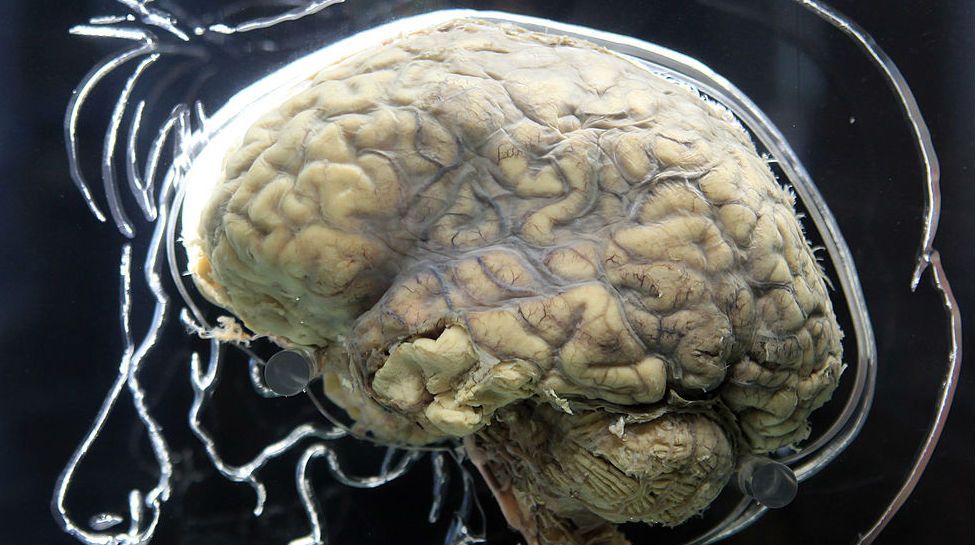Human brains show larger-than-life activity at moment of death
The brains of dying people may spark to sudden life in their final moments.
Two apparently brain-dead people taken off of life-support showed sudden spikes in neural activity, according to a study published on Monday.
The findings published in Proceedings of the National Academy of Sciences provide scientific support for accounts of “near-death experiences” — powerful and often mystical experiences that happen when a patient is about to die.
But they also shed new light into the surprisingly murky question of just how we die, said Jimo Borjigin of the University of Michigan.
In a small study of four patients taken off life support, Borjigin’s team found something surprising: the brains of two out of the four burst to life in the moments before death.
In particular, the patients displayed a sudden surge in the specific type of brain waves that usually indicate conscious thought.
Production of those brain waves — called gamma waves — spiked up to three hundred times in their previous levels in one patient in the moments before death.
That dying patient’s gamma wave patterns reached levels higher than those found in normal conscious brains.
The process our bodies and brains go through when we die remains poorly understood. In the conventional account, death is simply the sudden end of the processes of life — in particular, brain and heart activity.
For example, scientists don’t really understand what is happening on the inside when an apparently healthy person suffers a sudden trauma — like a car accident, fall or heart attack — and quickly dies.
“If you don’t know how exactly they die, how do you save them?” Borjigin asked
In practice, someone is legally dead when they are pronounced dead by a medical professional.
That professional doesn’t make that call based on a searching inventory of the patient’s subjective mental state — but based on the persistent absence of either a heartbeat or brain waves.
After a long period of such inactivity, family members often elect to disconnect a patient from breathing machines, at which point their body slowly dies from lack of oxygen.
But the recent findings suggest something more complex and harder to detect is going on. Borjigin points out there remains the possibility that a “covert consciousness” — a conscious experience we aren’t currently able to detect — continues below the surface, and springs to urgent life as death approaches.
That may be an adaptive response similar to the surge of cognitive activity that wakes a sleeping person (or, perhaps, a seal) with sleep apnea — in which the body stops breathing while asleep — in time to recover, Borjigin said.
“The brain has an extremely sensitive mechanism to sense oxygen levels in your body,” she said. “Even tiny drops of oxygen levels — the brain knows about that and constantly regulates the supply of oxygen.”
That goes against the idea of the brain as a passive passenger — which, Borjigin argues, makes sense.
“To think that when you are undergoing cardiac arrest — where the heart is stopping or not pumping blood — and the brain does nothing? It’s beyond me. The brain should be going crazy — which is exactly what happens,” she said.
Her next hypothesis is that “the brain drops everything else that is discretionary to focus on this essential function that is a survival, or self-resuscitation.”
This exploration of the inner territory of death is a far foray from Borjigin’s original area of specialization — circadian rhythms and the science of sleep.
In 2008, she was studying the impacts of stroke on the brain’s production of hormones that promote sleep, when she accidentally discovered something shocking.
In the moments right before death, the brains of the rats hooked up to their machines displayed a sudden surge in serotonin, a brain chemical deeply enmeshed in the processes of thought and sensing.
“Serotonin, as you probably know, is the essential neurotransmitter that’s important for brain functioning — which when it’s malfunctioning can leads to psychiatric disorders,” Borjigin told The Hill.
“So first thing I was thinking — ‘Wow. I wonder if the rats are having hallucinations?’”
Her second thought was that this serotonin surge was probably a well-understood phenomenon. She was wrong — both about that and the understanding of the general mechanics of dying. “I started looking into the literature, and I was surprised to find we know literally almost nothing.”
In the conventional understanding of death, the brain is a semi-passive passenger carried along by the heart — and which dies when the heart dies, Borjigin said.
There’s not much room in that model, however, for what Borjigin had found: a sudden surge of activity in dying brains. She built on those findings in a 2013 PNAS study that found that the brains of dying rats produced a surge of gamma waves — the pattern indicative of consciousness — as they experienced heart attacks.
“These data demonstrate that the mammalian brain can, albeit paradoxically, generate neural correlates of heightened conscious processing at near-death,” her team wrote in the 2013 paper.
That sentence contains an important caveat, and it is one that hangs over all this research. Dying rats may show “correlates” or traces of the activity that, in conscious mammals, is linked to coherent brain activity — but it’s so far impossible to know, subjectively, what dying rats or humans are experiencing.
Nonetheless, the 2013 paper, with its findings of surging brain activity in dying rats, made the New York Times. Its findings, the Times wrote, could “hold an explanation for the vivid, realistic visions experienced by some human victims of cardiac arrest” — visions reported by about 20 percent of heart attack patients.
These findings, Borjigin wrote at the time, could “explain why some individuals, during this state, can actually recall conversations happening in the operating room.”
These findings helped push Borjigin to the frontiers of consciousness research. Her sleep research focused on the pineal gland, a roughly almond-shaped organ under the forehead that releases the hormones that regulate sleep — and that many philosophical traditions have hypothesized as the seat of consciousness.
In 2013, Borjigin worked with Rick Strassman of the University of Mexico School of Medicine on a study that found the chemical dimethyltryptamine (DMT) — the active ingredient in the powerful Amazonian psychedelic ayahuasca — in the pineal glands of rats.
Strassman is a leading scientist who helped relaunch research into medical applications of psychedelics in the 1990s — sparking a renaissance in a field that medicine had largely turned away from since the 1970s.
Many of Strassman’s hypotheses — including that the brain releases a rush of DMT at death, a phenomenon he suggested could be related to end-of-life religious experiences — sit uneasily with the mainstream understanding of medicine.
But in 2019, Borjigin and Strassman found that dying rat brains released a surge of DMT as well.
That’s a strong indicator that human brains are doing something similar, Borjigin told an interviewer at the time — because cognitive phenomena found in rats usually display in people too, although not vice versa.
It’s hard to investigate much beyond that, however. The tests for a dying surge of DMT are highly invasive, and — absent end-of-life volunteers willing to have their skulls opened as they die in the name of science — very hard to corroborate.
And while the National Institutes of Health has poured money and attention over the past several years into the medical applications of psychedelics — particularly around curing depression or quitting dangerous drugs like alcohol or cigarettes — those studies largely focus on helping those who are unambiguously alive.
Also, “while psychedelic research has recently seen a renaissance, it’s mostly the use of psychedelics as a medicine or as a drug,” Borjigian added — rather than the study of how similar chemicals are produced and used by mammalian brains.
Since she began her studies on the cognitive life of the dying a decade ago, Borjigin hasn’t gotten a single NIH grant, she told The Hill.
“We definitely need to expand our studies, and we need NIH funders for these kinds of studies — to just study a lot more patients, maybe in a whole national network.”
That could lead to a reappraisal of the way the heart and brain work together to stave off the point of death — and therefore, potentially, to better understand their role in keeping us alive, Borjigin said.
Source: The Hill


